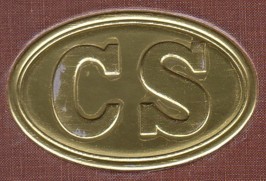

|
European-made revolvers
|
EUGENE LEFAUCHEUX
Son of Casimir, who invented the pinfire system, Eugène Lefaucheux proved himself very early as a genious gunmaker and an excellent businessman. It would take too long to tell the whole story of his life in this chapter, but we can view the headlines of it.
Born in 1832, he became very young familiar with the drawing techniques and manufacture of the pinfire arms invented by his father. He proofed very interested and very skilful on the field of gun mechanisms, and when his father died in 1852, as he was the sole survivor of seven children, he inherited not only his father's shop and patents, but above all his father's geniality and deep interest for mechanic in general.
With a view to developing his father's business at the best, Eugène went to Liège in order to enhance his knowledge. At Liège he learned not only the practical manufacture techniques in use in the imposant Belgian arms industry, but also the art of negotiation that was in use in well-established local companies such as Pirlot, Dandoy, Francotte and Colette.
Back in Paris at the end of 1853, he obtained a loan from his future father-in-law, which he invested in remodelling and modernization of his father's installations at the 37, rue Vivienne, that had been kept running by his mother during his stay at Liège. His success would see no end.
During the year he was in Liège, Eugène was very impressed by the Belgian copies of the Colt Pocket 1849 and Navy 1851 revolvers. As can be seen on the drawings of his very first patent application
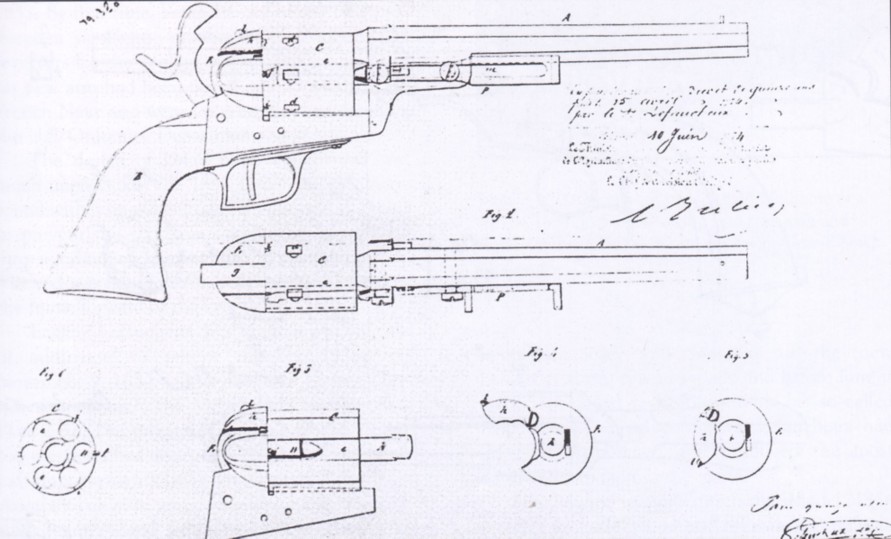
, those models were the ones he intended to adapt to the pinfire system. Although the name Colt was not mentioned in any documents, his first idea was evidently based on these very popular revolvers.
Yet Eugène's idea was not exactly to adapt existing weapons to his new system; instead, he intended to patent and protects a new system that could modernize any existing revolver.
This lead he to apply, in April 1854, for a patent for a new type of revolver, that would become the most largely used military handgun in Europe for decades to come. Thousands of copies and derivates of this arm would make the fortune of Belgian, French, British, German, Danish, Spanish, Russian and other European gunmakers. He was granted the patent n° 19380 on June 10, 1854; and exactly 12 days later, he applied for the same at the London Patent Office, this time with the drawings of an arm that would become the famous model 1854 revolver
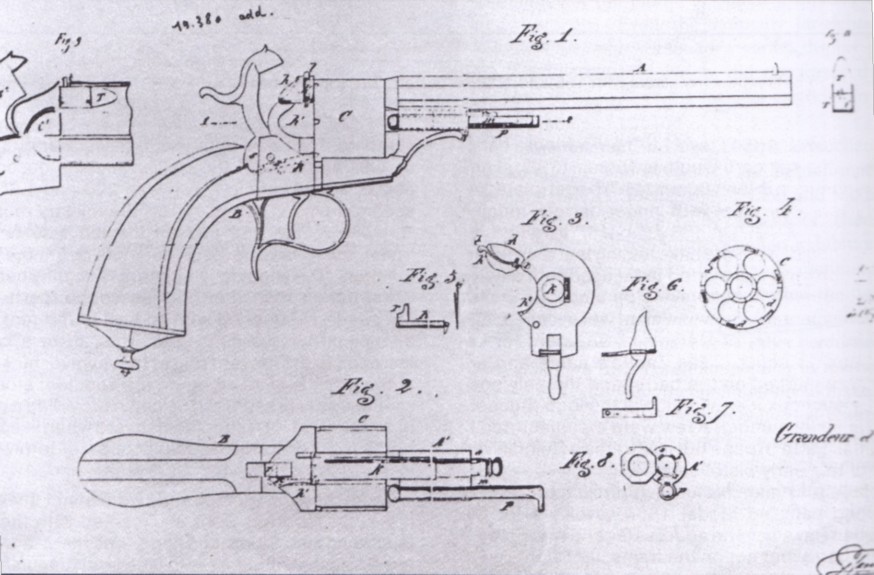
He was granted the patent n° 995 in July, 1854, and it was that very patent that discouraged Rollin White, the American inventor of the bored-through cylinder, to apply for any patent in Europe.
THE MODEL 1854 REVOLVER
The 1854 is an open-top, single-action revolver, with a 3-piece structure that reminds that of the Colt. But resemblance stops there.
Almost as powerful as the Colt and sturdier and reliable, the lefaucheux has the immense advantage of using a very reliable ammunition, easy and fast to load, totally insensible to weather conditions, and quite light, which makes it easy to carry.
The revolver is very easy to handle, and can be used by anyone, which is not always the case with percussion revolvers such as Colt, Remington or Adams.
Eugène Lefaucheux Model 1854 revolver may be called the most advanced handgun in the world in that era.
The revolver was manufactured for both the civilian and the foreign military open markets. It is marked "IVon E. Lefaucheux Breveté S.G.D.G. on top of the barrel or on the left side of the frame under the cylinder, or on both places. The serial number, with in front of it the "broken pistol" logo and the initials LF, is stamped on the right side of the frame. The 12 mm (.472 inch) calibre barrel has a length of 155 mm.
Apart from minor modifications, the revolver would remain unchanged during its entire production period. Photo 3 shows one of the very early models with octagonal barrel, photos 4,5 and 6
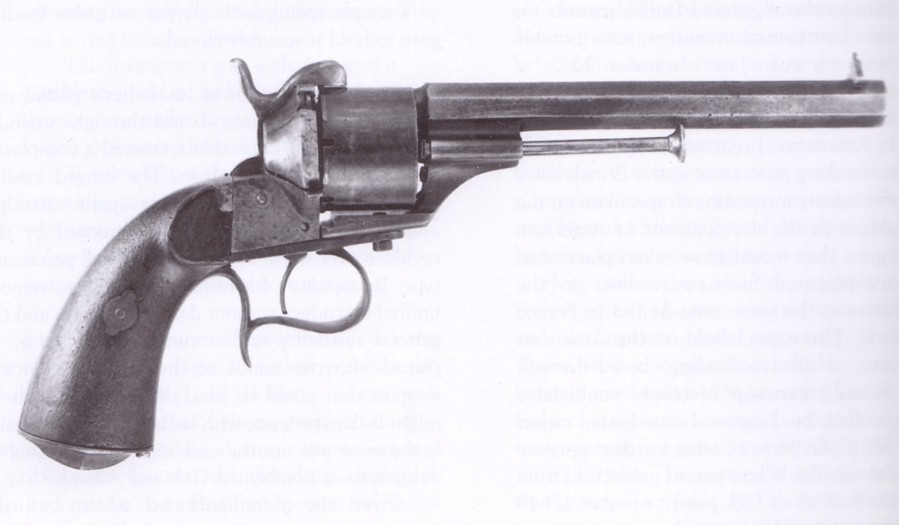
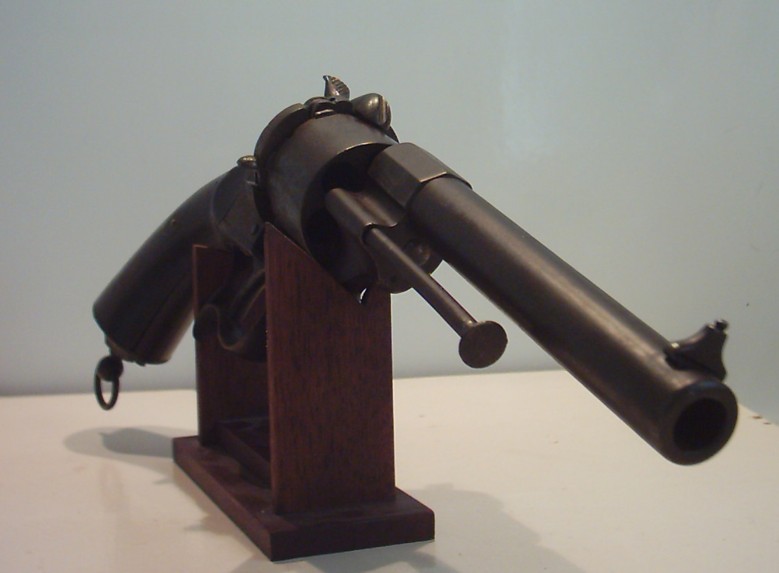
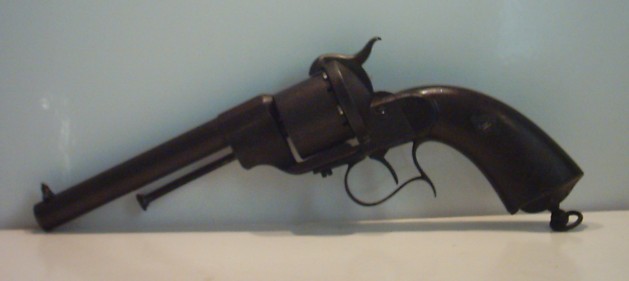
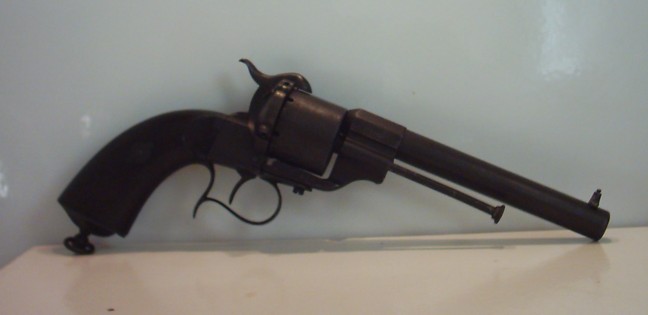
show the standard model, serial# 34059, that might have been carried by a Supply Officer in the 21st Michigan Infantry Rgt. It has the markings on both barrel and frame.
Usually, the "military" or "cavalry" model has the spur trigger guard and the "diamond" but, while the "civilian" model has a round trigger guard and a flat, little convex butt.
The civilian model is often confused with the "1858 Navy Model".
Hundreds of thousands of these revolvers were manufactured and have been in use in various European armies; many Belgian and Spanish copies were made. But let's get back to the States and the American Civil War...
UNION ARMY PURCHASES
Although they were aware of the qualities of the Lefaucheux and did know about its adoption by the French Army, and despite all favourable reports, the US Ordnance Dept did not show any interest until May, 1857. After a number of tests, the Lefaucheux revolver was judged excellent and was recommended as the best sidearm for the Cavalry. It was also promoted by the Sharps Company. However, some American nationalism leads the large contracts to be signed with the large home producers such as Colt, Remington and Starr, who were still producing the already obsolete percussion arms. The Lefaucheux became an appreciated military sidearm after the fall of Fort Sumter in 1861.
Just before the beginning of the Civil War, Eugène Lefaucheux had obtained the US patent n° 31809 that covered his revolver and also a rifle. Later on, between September, 1861 and June, 1862, the Union Army purchased a total of 11,833 Lefaucheux model 1854 revolvers. 10,000 of these were directly delivered by Eugène Lefaucheux himself; 1,500 were purchased through Alexis Godillot, gunmaker at Paris and Liège, and the remaining 333 by 6 other American traders. ALL these revolvers were manufactured by E. Lefaucheux in his Parisian shop, and bear serial numbers from 25067 to 36900. They were all issued to units and saw use during the whole war. The Union Army also purchased 1,856,680 12 mm rounds for these weapons. About 10 % of these ammunitions were produced in the USA by CD Leet & Co (this company is known by its venture with Gallager).
CONFEDERATE ARMY PURCHASES
It is known that Captain Caleb Huse, then aged 31, was in London and had carte blanche for buying as most small arms as possible for the account of the Confederacy.
We also know that his largest supplier was the London Armoury Co, who sold him 80,000 Enfield rifles and 9,000 Kerr percussion revolvers.
It has also been established that Huse purchased a great number of Lefaucheux 1854 revolvers through that company. Moreover, the London Armoury had been selling firearms in the States before and during the Civil War, through its agency there.
Although very scarce, the existing Confederate records allow an estimation of about 250,000 handguns of various types imported by the Confederacy during wartime.
These weapons came mostly from England, France and Belgium. The exact number of model 1854 Lefaucheux used by Confederate troops is unknown, but the tintypes that have survived prove that the revolver was widely used. On the other hand, as they were encountering major difficulties in finding weapons and ammunition, the Confederate troops have used all kinds of available 12 mm pinfire revolvers, and also the 9 mm and even the small 7 mm ones.
As the war went on, the Union blockade became more and more effective, and forced the Confederate to import in fractioned shipments, through the Bermudas and other destinations, with various fake descriptions of goods on their documents. They have even bought weapons in New York from Confederate sympathisants such as Schuyler or Hartly & Graham, and passed the weapons through the Union lines.
Without any detailed archives, it is very difficult to estimate the number of 1854 Lefaucheux revolver used by the Confederate troops. However, different authors concur to estimate the number of that model only to be somewhere between 2,000 and 5,000.
Marcel